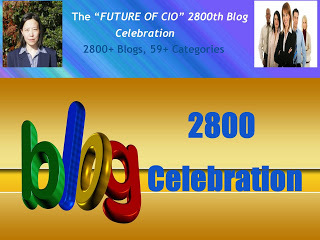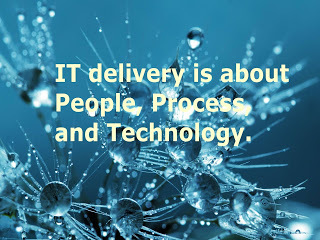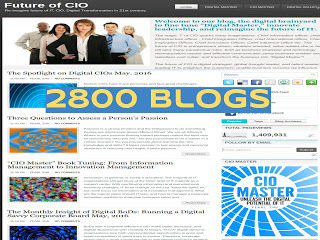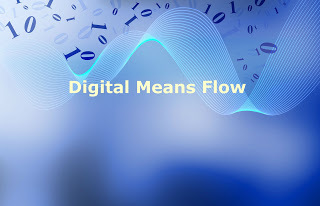Pearl Zhu's Blog, page 1336
May 19, 2016
What Should be the Digital CIO’s Outside-in Business Focus
 Most of the top CIOs understand that the digital transformation of most of the organizations depends, to a large extent, on their capabilities to transform IT from an inside-out focus into an outside-in focus. They must devote their time and energy, understanding the business and the potential of digital technologies to optimize customer experiences, improve business processes and work with other senior executives to develop new digital enabled business models. This should be the focus of the digital CIO. Digital CIOs should continue to ask themselves? Can you understand the focus / goals of the company to ensure IT is focused on those goals? Does IT have the vision necessary for the business to succeed and grow? And what’s your 360 degrees of the business view?
Most of the top CIOs understand that the digital transformation of most of the organizations depends, to a large extent, on their capabilities to transform IT from an inside-out focus into an outside-in focus. They must devote their time and energy, understanding the business and the potential of digital technologies to optimize customer experiences, improve business processes and work with other senior executives to develop new digital enabled business models. This should be the focus of the digital CIO. Digital CIOs should continue to ask themselves? Can you understand the focus / goals of the company to ensure IT is focused on those goals? Does IT have the vision necessary for the business to succeed and grow? And what’s your 360 degrees of the business view?CIOs need to expand their lenses to both the business dimension as well as the technology dimension with their team: Today’s organizations are at a crossroads where the segregation or siloing of business units are at a need to reach across the aisles and respectively work with each other. Even go one step further, the top digital CIO understands what current technology innovations can add business value and transfer this to the business. The best IT leaders and managers always have a strong understanding of what the business does, how it does it, and how it could be better with 360 degrees of business view. IT delivers the best solution to the business problems which meet business’s requirement or tailor customer’s needs. IT should facilitate the business partners to the right solutions and help to implement them.
Learn the business via empathetic listening: The best way to achieve partnership is to listen to what the business says they need. Let them tell you their stories, challenges. LISTEN to your clients, stakeholders, vendors, partners and staff. Be careful, you do not want to come across as having a solution looking for a problem. You have to know and relate to what they value and how they quantify that value first before you can add real value. The CIO needs to take those needs and translate them into an IT investment to support that vision and fix the “lost in translation” syndrome. Hence, ensuring that you have the commitment from the senior executives to engage in both formal and informal dialogue to derive a viable business strategy that is enabled or driven by IT would be good. To listen, comprehend and understand the people and the business they are part of, before embarking on any new way of thinking to know where you have come from enables you to move to a new place even quicker. The CIO need to understand the needs of the different business units, but their needs / vision would be spelled out by their leaders, not the CIO.
 Make IT more shared, integrated, flexible, reliable, and fast: The best CIOs are good sales people who see opportunities to save money, become more customer experience oriented, or come up with definitive competitive advantages, and with a business mindset. Get engaged in the investment process prior to the decision already being made. Develop and socialize a strategic business plan that aligns both business strategies and technical direction. As a result, you'll have an IT organization that is viewed as a business partner that adds business value, and become the business. It starts with building strong and value-creating relationships with C-suites, between IT and vendors or suppliers; and build a strong team with a strong bench. Conduct presentations with management on new technology areas that have a short-term business impact on broadening their view of the team. Setup idea forums to engage the business and build business liaisons proactively to help shape the problem or opportunity before it becomes a project. This starts to build credibility outside of just managing the "run" side of things. Grow, and catalyze business transformation, IT can become a strategic business partner.
Make IT more shared, integrated, flexible, reliable, and fast: The best CIOs are good sales people who see opportunities to save money, become more customer experience oriented, or come up with definitive competitive advantages, and with a business mindset. Get engaged in the investment process prior to the decision already being made. Develop and socialize a strategic business plan that aligns both business strategies and technical direction. As a result, you'll have an IT organization that is viewed as a business partner that adds business value, and become the business. It starts with building strong and value-creating relationships with C-suites, between IT and vendors or suppliers; and build a strong team with a strong bench. Conduct presentations with management on new technology areas that have a short-term business impact on broadening their view of the team. Setup idea forums to engage the business and build business liaisons proactively to help shape the problem or opportunity before it becomes a project. This starts to build credibility outside of just managing the "run" side of things. Grow, and catalyze business transformation, IT can become a strategic business partner.
As CIOs will continue to be put on the front line, they need to ensure their organizations are ready for change, space and time are made to scope, plan and execute the project. CIO can help business to improve net by improving both the top line revenue growth and at the same time decreasing expenses to improve the bottom line. And more importantly, run, growth, and transform, IT can strike the right balance to both reap the low-hanging fruit and drive the business's long-term digital transformation.
Follow us at: @Pearl_Zhu
Published on May 19, 2016 23:49
May 18, 2016
Talent Management Monthly Brief: See Through Talent from Different Angles X May. 2016
 People are always the most invaluable asset in businesses. “Hiring the right person to the right position at the right time,” is the mantra of many forward-thinking organizations. The question is how would you define the right people? How do you define wrong, average, mediocre, good, great or extraordinary person? Or put simply, for what should they be right? Traditional Performance Management focusing on measuring what an employee does (mainly being told to do) in quantitative way is not sufficient to identify high performance or high potential, should we see through talent from different angles?
People are always the most invaluable asset in businesses. “Hiring the right person to the right position at the right time,” is the mantra of many forward-thinking organizations. The question is how would you define the right people? How do you define wrong, average, mediocre, good, great or extraordinary person? Or put simply, for what should they be right? Traditional Performance Management focusing on measuring what an employee does (mainly being told to do) in quantitative way is not sufficient to identify high performance or high potential, should we see through talent from different angles?
See Through Talent from Different Angles Three Questions to Assess a Person’s Agility Agility is related many things such as adaptability, flexibility, changeability, robustness, sensitivity, comprehensiveness, speed, responsiveness, etc. Either at the business level or from the individual perspective, agility is the multidimensional competencies to adapt to changes, formulate creative or unconventional alternatives or solutions to resolve problems, to show versatility and flexibility in response to unpredictable or unanticipated circumstances. It’s a crucial ability to thrive in today’s “VUCA” normality. Which questions should you ask to assess an individual’s agility?
Three Questions to Assess a Person’s Vision Vision is about having a positive outlook on the future that is not predicated on the past or present. The vision needs to be a good metaphor - 'the guiding light,' so that people can see themselves and their work reflected in it. It is through identifying the "destination" for all, charting the route for all from their own respective positions toward the destination, and then guiding along the way when some for a time deviate or supporting the ones who are lagging behind. There is also a passionate connection to a vision. When a vision is realized, people live with change. Which questions should you ask to assess a person’s vision?Three Questions to Assess a Person’s “Out-of-Box” Thinking Ability Every mind has a certain box, some smaller, some bigger. The box starts set-up at a very early age, by your surroundings, the media you followed, the books you read, the education you received, the people you interacted with and the standards by which you lived. The "boxes" are the walls in your mind. Walls in your mind are constructed by the society's conditioning and rules imposed by influencers. However, the box keeps changing, in today's competitive environment, what was outside the box yesterday, may not be such today. Our thinking has to continuously evolve, adapt, and prepare for change. Which questions should you ask to assess a person’s “Out-of-box” thinking ability?
Three Questions to Assess a Person's Courage: Many people cannot get out of ‘comfort zone” due to fears or doubt, or to put simply, lack of courage. Fear has always been one of the major obstacles to change--fear of failure, fear of loss of control, etc. Fear can paralyze an individual to do nothing or become manipulated mentality to spur negative emotions. Fear will drive you away from your personal goals, your ambitions, your standards, and norms. Likewise, fear can paralyze a company to maintaining status quo, refusing to adapt to change. It turns to become such counter-productive behavior when the contribution of others offers the potential to add so much value. To achieve success, either at the individual or organizational level, it is necessary to have “enthusiasm,” and courage, based on the inner strength that is able to increase the quality of the individual and collective performance. So which questions should you ask to assess a person’s courage?
 Three Questions to Assess a Person’s Humility The humility comes from being humble and admitting that you don't have all of the answers. Getting on the level of those being led and really listening to understand the circumstances profoundly. Be confident to ask, be curious to learn more and be inclusive to understand other’s PoVs. Cultivate great listening skills with equivalent questions. Be polite, charm, patience, and tolerance for people in conversation and collaboration. It is a crucial quality for today's digital leaders and professionals because overwhelming information and unprecedented uncertainty. Which questions should you ask to assess a person’s humility?
Three Questions to Assess a Person’s Humility The humility comes from being humble and admitting that you don't have all of the answers. Getting on the level of those being led and really listening to understand the circumstances profoundly. Be confident to ask, be curious to learn more and be inclusive to understand other’s PoVs. Cultivate great listening skills with equivalent questions. Be polite, charm, patience, and tolerance for people in conversation and collaboration. It is a crucial quality for today's digital leaders and professionals because overwhelming information and unprecedented uncertainty. Which questions should you ask to assess a person’s humility?The “Future of CIO” Blog has reached 1.3+million page views with about #2800+ blog posting in 59+ different categories of leadership, management, strategy, digitalization, change/talent, etc. blog posting. The content richness is not for its own sake, but to convey the vision and share the wisdom, to inspire critical thinking and spur healthy debates. Blogging is not about writing, but about thinking and innovating the new ideas; it’s not just about WHAT to say, but about WHY to say, and HOW to say it. It reflects the color and shade of your thought patterns, and it indicates the peaks and curves of your thinking waves. Unlike pure entertainment, quality and professional content takes time for digesting, contemplation and engaging, and therefore, it takes time to attract the "hungry minds" and the "deep souls." It’s the journey to amplify diverse voices and deepen digital footprints, and it's the way to harness your innovative spirit.
Follow us at: @Pearl_Zhu
Published on May 18, 2016 23:23
“WHY, WHAT, and HOW” in Authentic Leadership
 Leadership is complex yet simple. Complex in that there are so many traits and characteristics that are considered when evaluating a leader. Simplicity in that the substantial of leadership never changes, it’s about future. What are great questions to inspire authentic leadership and how to improve leadership effectiveness?
Leadership is complex yet simple. Complex in that there are so many traits and characteristics that are considered when evaluating a leader. Simplicity in that the substantial of leadership never changes, it’s about future. What are great questions to inspire authentic leadership and how to improve leadership effectiveness?
WHY do you want to lead? An authentic leader fills a certain gap or multiple gaps in order to lead to the future. Becoming a leader is a process of becoming your true authentic self in all that you are today. So rather than looking for examples of leaders out there, look within yourself and ask: Why do you want to lead? Why should others follow you? Being a leader takes one to have a desire to do better than others in certain domains while creating themselves a platform of influence in wherever they are. The intention of becoming a leader is to inspire and innovate, to improve and advance, to facilitate and encourage, as change is often an uncomfortable, yet necessary part of reaching and maintaining success. Authenticity is the foundation to be a thought leader. When you dig deeper in yourselves, the questions arise - Who are you? Where do your thoughts come from and so on? When you get some answers to these questions and get some clarity, the fountain of thought starts to flow, it helps you in identifying your intention, which instills action to serve the vision is perceived as leadership for the right cause,
WHAT is your leadership strength? The next step is investigating what’s your strength, your passion: defining your task, things you want to do and do better than others. Leadership is about future, what’s your leadership strength, what can you bring to the table? Do you have a clearer vision, advanced mindset, in-depth domain knowledge, or creativity? Digital leadership needs to be highly intelligent and highly influential. The emphasis is on trying to determine which competencies or capabilities should be used in which combination, and with what level of weight for each, for every different situation, in order to improve leadership effectiveness. An authentic leader has vision to serve as an enabler, and creativity to convey and reach vision. If vision is about the "end" status, then innovation is the means to the end.” “Vision" is a destination and 'innovation' is the better process, tools, cultures, etc. to get you there. Coaching and mentoring are going to be increasingly important now, and that’s why expert power is perhaps more powerful than other types of powers in the age of digitalization and globalization. The authentic leaders with high intelligence have adaptability, consistency, profundity, and empathy to master business dynamic and cultural cognizance.
 HOW can you improve leadership effectiveness? How can you take leadership to achieve organizational success? One of the most important things leaders can do for people they wish to lead is to work towards emotional connections with those they wish to influence. The leader creates the vision, the mission, the objective, the goal, whatever one wishes to call it. High-effective leadership needs the great capacity of (1) keeping the mind focused on the goal, (2) observing how people are and how they interact with the goal, (3) knowing how to motivate multi-generational workforce through inspiration, positive energy, co-creation, high-effective leaders will need to understand the root cause of the failure, less focus on command-control style management, more focus on peer-to-peer collaboration. Technology will help through transparency, idea sharing, linking and openness - only managers who will become leaders will survive. Effective digital leaders must be comfortable with remote team participation and work to develop team cohesion and synergy with the multi-location, multicultural, diversely skilled team, chartered with delivering the team's objective.
HOW can you improve leadership effectiveness? How can you take leadership to achieve organizational success? One of the most important things leaders can do for people they wish to lead is to work towards emotional connections with those they wish to influence. The leader creates the vision, the mission, the objective, the goal, whatever one wishes to call it. High-effective leadership needs the great capacity of (1) keeping the mind focused on the goal, (2) observing how people are and how they interact with the goal, (3) knowing how to motivate multi-generational workforce through inspiration, positive energy, co-creation, high-effective leaders will need to understand the root cause of the failure, less focus on command-control style management, more focus on peer-to-peer collaboration. Technology will help through transparency, idea sharing, linking and openness - only managers who will become leaders will survive. Effective digital leaders must be comfortable with remote team participation and work to develop team cohesion and synergy with the multi-location, multicultural, diversely skilled team, chartered with delivering the team's objective. Leadership is complex, and although it has many facets, at its core, the foundation of leadership is based on authenticity. Ask the big “WHY” question to discover your intention to lead. It’s also important to discover and enforce your own leadership strength, in order to amplify leadership influence and improve leadership effectiveness. The ultimate criterion of "high-influential leadership," is the ability to create more leaders, to spread leadership - or, more precisely, to groom more authentic leaders with the ability to think differently, independently and innovatively. Follow us at: @Pearl_Zhu
Published on May 18, 2016 23:17
"CIO Master" Book Tuning XXXIV: Running IT as DIgital Capability Builder of the Organization
Defining your enterprise business capability is part art and part science.
 Forward-looking organizations are making a continuous journey shifting from an inside-out operation driven organization to an outside-in customer-centric business; to improve competency, they also shift from process-oriented practices to capability-based strategy management. IT plays a more important role in such a digital paradigm shift. The capability is the ability to achieve the desired effect under specified performance, standards and conditions through combinations of ways and means (activities and resources) to perform a set of activities. What are differentiated business capabilities can IT help to build for business to gain long term advantage?
Forward-looking organizations are making a continuous journey shifting from an inside-out operation driven organization to an outside-in customer-centric business; to improve competency, they also shift from process-oriented practices to capability-based strategy management. IT plays a more important role in such a digital paradigm shift. The capability is the ability to achieve the desired effect under specified performance, standards and conditions through combinations of ways and means (activities and resources) to perform a set of activities. What are differentiated business capabilities can IT help to build for business to gain long term advantage?
Decision-making capability: IT is the steward of the business information. Information and decision-making are intimately connected and interdependent. The fundamental responsibility of IT is to ensure the right people getting the right information to make right decisions at the right time. Decisions are based on information and generate information. The amount of data required for a decision, and the amount of information generated by a decision, can both be measured in bits or bytes. Or to put it another way, for decision-making to be effective, the decision-maker must have enough knowledge to make their decisions rich in information, "information" as input to the decision-making does not absolutely determine the decision but allows the decision-maker to exercise their judgment. Information as output of decision-making can also be managed as business knowledge to benefit for future decision-making.
Change capability: For forward-looking and highly mature organizations, the IT department has become synonymous with the change department to improve business agility -The ability for business to create necessary change and adapt to changes. A mature organization is one that can quickly and safely assess all of the consequences of a possible change and devise effective plans to achieve and sustain those changes - and to do this continuously. How do you make changes to anything without knowing all the parts and how they are related? In order to make effective changes, you have to know the underneath structure and processes of your business, because they underpin digital capabilities of the organization. Fundamentally, change consists of one or more of the following: people change, process change, and technology change, and IT is not only the superglue but also the integrator to weave all important change elements effortlessly and make change sustainable. The IT department has been left to run change project, to have a good understanding from a strategic perspective of the organization (structure, processes, locations, drivers, objectives, goals, applications, data, technologies.). Thus, IT is a crucial element for improving business agility.
 Innovation capability: Innovation is change, but change does not always mean innovation. At the higher level of maturity, IT needs to run as a business' innovation engine. Innovation management is about transforming new ideas to achieve its business value. Innovation follows basic rules which are adapted depending the one company’s situation and ambition. The digital mantra for forward-looking IT organization is to do more with innovation. It doesn’t just about innovation within IT, IT has always been very innovative regarding technology, but for many lower mature IT, The missing part is business innovations. The innovative nature of IT can be used to the benefit of business only when IT participates in defining strategy and business goals and make IT as a business driver and strategic asset. An effective IT can drive all sorts of innovation, proactively pushing ideas on how to leverage technologies to drive business growth, increasing business productivity, digitizing talent management, building business competency and improving customer satisfaction.
Innovation capability: Innovation is change, but change does not always mean innovation. At the higher level of maturity, IT needs to run as a business' innovation engine. Innovation management is about transforming new ideas to achieve its business value. Innovation follows basic rules which are adapted depending the one company’s situation and ambition. The digital mantra for forward-looking IT organization is to do more with innovation. It doesn’t just about innovation within IT, IT has always been very innovative regarding technology, but for many lower mature IT, The missing part is business innovations. The innovative nature of IT can be used to the benefit of business only when IT participates in defining strategy and business goals and make IT as a business driver and strategic asset. An effective IT can drive all sorts of innovation, proactively pushing ideas on how to leverage technologies to drive business growth, increasing business productivity, digitizing talent management, building business competency and improving customer satisfaction.
Defining your enterprise business capability is part art and part science. IT needs to become the digital capability builder of the organization. Because Business capabilities are fundamental pillars to achieve the corporate strategy, and business information is the very clue to understanding every step of customer purchasing, and technology is digitizing every touch point of customer experience. Digital IT is the integrator and superglue to recombinant dynamic business capabilities, without them, strategy execution can not be sustained.
CIO Master Order Link on Amazon CIO Master Ordre Link on Barner & Noble CIO Master Order Link On IBooks “CIO Master” Book Preview Quote Collection III “CIO Master” Book Preview Quote Collection II “CIO Master” Book Preview Quote Collection I, Slideshare Presentation “CIO Master” Book Preview Conclusion Running IT as Digital Transformer “CIO Master” Book Preview: Chapter 9 IT Agility “CIO Master” Book Preview: Chapter 8 Three "P"s in Running Digital IT “CIO Master” Book Preview: Chapter 7 IT Innovation Management “CIO Master” Book Preview: Chapter 6 Digital Strategy-Execution Continuum "CIO Master” Book Preview: Chapter 5 Thirteen Digital Flavored IT “CIO Master” Book Preview: Chapter 4 CIO as Talent Master Introduction “CIO Master” Book Preview: Chapter 3 “CIOs as Change Agent” Introduction “CIO Master” Book Preview: Chapter 2 “CIOs as Digital Visionary” Introduction “CIO Master” Book Preview: Chapter 1 “Twelve Digital CIO Personas” Introduction "CIO Master - Unleash the Digital Potential of IT" Introduction "CIO Master - Unleash the Digital Potential of IT" Book Preview
Follow us at: @Pearl_Zhu
 Forward-looking organizations are making a continuous journey shifting from an inside-out operation driven organization to an outside-in customer-centric business; to improve competency, they also shift from process-oriented practices to capability-based strategy management. IT plays a more important role in such a digital paradigm shift. The capability is the ability to achieve the desired effect under specified performance, standards and conditions through combinations of ways and means (activities and resources) to perform a set of activities. What are differentiated business capabilities can IT help to build for business to gain long term advantage?
Forward-looking organizations are making a continuous journey shifting from an inside-out operation driven organization to an outside-in customer-centric business; to improve competency, they also shift from process-oriented practices to capability-based strategy management. IT plays a more important role in such a digital paradigm shift. The capability is the ability to achieve the desired effect under specified performance, standards and conditions through combinations of ways and means (activities and resources) to perform a set of activities. What are differentiated business capabilities can IT help to build for business to gain long term advantage?
Decision-making capability: IT is the steward of the business information. Information and decision-making are intimately connected and interdependent. The fundamental responsibility of IT is to ensure the right people getting the right information to make right decisions at the right time. Decisions are based on information and generate information. The amount of data required for a decision, and the amount of information generated by a decision, can both be measured in bits or bytes. Or to put it another way, for decision-making to be effective, the decision-maker must have enough knowledge to make their decisions rich in information, "information" as input to the decision-making does not absolutely determine the decision but allows the decision-maker to exercise their judgment. Information as output of decision-making can also be managed as business knowledge to benefit for future decision-making.
Change capability: For forward-looking and highly mature organizations, the IT department has become synonymous with the change department to improve business agility -The ability for business to create necessary change and adapt to changes. A mature organization is one that can quickly and safely assess all of the consequences of a possible change and devise effective plans to achieve and sustain those changes - and to do this continuously. How do you make changes to anything without knowing all the parts and how they are related? In order to make effective changes, you have to know the underneath structure and processes of your business, because they underpin digital capabilities of the organization. Fundamentally, change consists of one or more of the following: people change, process change, and technology change, and IT is not only the superglue but also the integrator to weave all important change elements effortlessly and make change sustainable. The IT department has been left to run change project, to have a good understanding from a strategic perspective of the organization (structure, processes, locations, drivers, objectives, goals, applications, data, technologies.). Thus, IT is a crucial element for improving business agility.
 Innovation capability: Innovation is change, but change does not always mean innovation. At the higher level of maturity, IT needs to run as a business' innovation engine. Innovation management is about transforming new ideas to achieve its business value. Innovation follows basic rules which are adapted depending the one company’s situation and ambition. The digital mantra for forward-looking IT organization is to do more with innovation. It doesn’t just about innovation within IT, IT has always been very innovative regarding technology, but for many lower mature IT, The missing part is business innovations. The innovative nature of IT can be used to the benefit of business only when IT participates in defining strategy and business goals and make IT as a business driver and strategic asset. An effective IT can drive all sorts of innovation, proactively pushing ideas on how to leverage technologies to drive business growth, increasing business productivity, digitizing talent management, building business competency and improving customer satisfaction.
Innovation capability: Innovation is change, but change does not always mean innovation. At the higher level of maturity, IT needs to run as a business' innovation engine. Innovation management is about transforming new ideas to achieve its business value. Innovation follows basic rules which are adapted depending the one company’s situation and ambition. The digital mantra for forward-looking IT organization is to do more with innovation. It doesn’t just about innovation within IT, IT has always been very innovative regarding technology, but for many lower mature IT, The missing part is business innovations. The innovative nature of IT can be used to the benefit of business only when IT participates in defining strategy and business goals and make IT as a business driver and strategic asset. An effective IT can drive all sorts of innovation, proactively pushing ideas on how to leverage technologies to drive business growth, increasing business productivity, digitizing talent management, building business competency and improving customer satisfaction.
Defining your enterprise business capability is part art and part science. IT needs to become the digital capability builder of the organization. Because Business capabilities are fundamental pillars to achieve the corporate strategy, and business information is the very clue to understanding every step of customer purchasing, and technology is digitizing every touch point of customer experience. Digital IT is the integrator and superglue to recombinant dynamic business capabilities, without them, strategy execution can not be sustained.
CIO Master Order Link on Amazon CIO Master Ordre Link on Barner & Noble CIO Master Order Link On IBooks “CIO Master” Book Preview Quote Collection III “CIO Master” Book Preview Quote Collection II “CIO Master” Book Preview Quote Collection I, Slideshare Presentation “CIO Master” Book Preview Conclusion Running IT as Digital Transformer “CIO Master” Book Preview: Chapter 9 IT Agility “CIO Master” Book Preview: Chapter 8 Three "P"s in Running Digital IT “CIO Master” Book Preview: Chapter 7 IT Innovation Management “CIO Master” Book Preview: Chapter 6 Digital Strategy-Execution Continuum "CIO Master” Book Preview: Chapter 5 Thirteen Digital Flavored IT “CIO Master” Book Preview: Chapter 4 CIO as Talent Master Introduction “CIO Master” Book Preview: Chapter 3 “CIOs as Change Agent” Introduction “CIO Master” Book Preview: Chapter 2 “CIOs as Digital Visionary” Introduction “CIO Master” Book Preview: Chapter 1 “Twelve Digital CIO Personas” Introduction "CIO Master - Unleash the Digital Potential of IT" Introduction "CIO Master - Unleash the Digital Potential of IT" Book Preview
Follow us at: @Pearl_Zhu
Published on May 18, 2016 23:08
Running IT as DIgital Capability Builder of the Organization
Defining your enterprise business capability is part art and part science.
 Forward-looking organizations are making a continuous journey shifting from an inside-out operation driven organization to an outside-in customer-centric business; to improve competency, they also shift from process-oriented practices to capability-based strategy management. IT plays a more important role in such a digital paradigm shift. The capability is the ability to achieve the desired effect under specified performance, standards and conditions through combinations of ways and means (activities and resources) to perform a set of activities. What are differentiated business capabilities can IT help to build for business to gain long term advantage?
Forward-looking organizations are making a continuous journey shifting from an inside-out operation driven organization to an outside-in customer-centric business; to improve competency, they also shift from process-oriented practices to capability-based strategy management. IT plays a more important role in such a digital paradigm shift. The capability is the ability to achieve the desired effect under specified performance, standards and conditions through combinations of ways and means (activities and resources) to perform a set of activities. What are differentiated business capabilities can IT help to build for business to gain long term advantage?
Decision-making capability: IT is the steward of the business information. Information and decision-making are intimately connected and interdependent. The fundamental responsibility of IT is to ensure the right people getting the right information to make right decisions at the right time. Decisions are based on information and generate information. The amount of data required for a decision, and the amount of information generated by a decision, can both be measured in bits or bytes. Or to put it another way, for decision-making to be effective, the decision-maker must have enough knowledge to make their decisions rich in information, "information" as input to the decision-making does not absolutely determine the decision but allows the decision-maker to exercise their judgment. Information as output of decision-making can also be managed as business knowledge to benefit for future decision-making.
Change capability: For forward-looking and highly mature organizations, the IT department has become synonymous with the change department to improve business agility -The ability for business to create necessary change and adapt to changes. A mature organization is one that can quickly and safely assess all of the consequences of a possible change and devise effective plans to achieve and sustain those changes - and to do this continuously. How do you make changes to anything without knowing all the parts and how they are related? In order to make effective changes, you have to know the underneath structure and processes of your business, because they underpin digital capabilities of the organization. Fundamentally, change consists of one or more of the following: people change, process change, and technology change, and IT is not only the superglue but also the integrator to weave all important change elements effortlessly and make change sustainable. The IT department has been left to run change project, to have a good understanding from a strategic perspective of the organization (structure, processes, locations, drivers, objectives, goals, applications, data, technologies.). Thus, IT is a crucial element for improving business agility.
 Innovation capability: Innovation is change, but change does not always mean innovation. At the higher level of maturity, IT needs to run as a business' innovation engine. Innovation management is about transforming new ideas to achieve its business value. Innovation follows basic rules which are adapted depending the one company’s situation and ambition. The digital mantra for forward-looking IT organization is to do more with innovation. It doesn’t just about innovation within IT, IT has always been very innovative regarding technology, but for many lower mature IT, The missing part is business innovations. The innovative nature of IT can be used to the benefit of business only when IT participates in defining strategy and business goals and make IT as a business driver and strategic asset. An effective IT can drive all sorts of innovation, proactively pushing ideas on how to leverage technologies to drive business growth, increasing business productivity, digitizing talent management, building business competency and improving customer satisfaction.
Innovation capability: Innovation is change, but change does not always mean innovation. At the higher level of maturity, IT needs to run as a business' innovation engine. Innovation management is about transforming new ideas to achieve its business value. Innovation follows basic rules which are adapted depending the one company’s situation and ambition. The digital mantra for forward-looking IT organization is to do more with innovation. It doesn’t just about innovation within IT, IT has always been very innovative regarding technology, but for many lower mature IT, The missing part is business innovations. The innovative nature of IT can be used to the benefit of business only when IT participates in defining strategy and business goals and make IT as a business driver and strategic asset. An effective IT can drive all sorts of innovation, proactively pushing ideas on how to leverage technologies to drive business growth, increasing business productivity, digitizing talent management, building business competency and improving customer satisfaction.
Defining your enterprise business capability is part art and part science. IT needs to become the digital capability builder of the organization. Because Business capabilities are fundamental pillars to achieve the corporate strategy, and business information is the very clue to understanding every step of customer purchasing, and technology is digitizing every touch point of customer experience. Digital IT is the integrator and superglue to recombinant dynamic business capabilities, without them, strategy execution can not be sustained.
Follow us at: @Pearl_Zhu
 Forward-looking organizations are making a continuous journey shifting from an inside-out operation driven organization to an outside-in customer-centric business; to improve competency, they also shift from process-oriented practices to capability-based strategy management. IT plays a more important role in such a digital paradigm shift. The capability is the ability to achieve the desired effect under specified performance, standards and conditions through combinations of ways and means (activities and resources) to perform a set of activities. What are differentiated business capabilities can IT help to build for business to gain long term advantage?
Forward-looking organizations are making a continuous journey shifting from an inside-out operation driven organization to an outside-in customer-centric business; to improve competency, they also shift from process-oriented practices to capability-based strategy management. IT plays a more important role in such a digital paradigm shift. The capability is the ability to achieve the desired effect under specified performance, standards and conditions through combinations of ways and means (activities and resources) to perform a set of activities. What are differentiated business capabilities can IT help to build for business to gain long term advantage?
Decision-making capability: IT is the steward of the business information. Information and decision-making are intimately connected and interdependent. The fundamental responsibility of IT is to ensure the right people getting the right information to make right decisions at the right time. Decisions are based on information and generate information. The amount of data required for a decision, and the amount of information generated by a decision, can both be measured in bits or bytes. Or to put it another way, for decision-making to be effective, the decision-maker must have enough knowledge to make their decisions rich in information, "information" as input to the decision-making does not absolutely determine the decision but allows the decision-maker to exercise their judgment. Information as output of decision-making can also be managed as business knowledge to benefit for future decision-making.
Change capability: For forward-looking and highly mature organizations, the IT department has become synonymous with the change department to improve business agility -The ability for business to create necessary change and adapt to changes. A mature organization is one that can quickly and safely assess all of the consequences of a possible change and devise effective plans to achieve and sustain those changes - and to do this continuously. How do you make changes to anything without knowing all the parts and how they are related? In order to make effective changes, you have to know the underneath structure and processes of your business, because they underpin digital capabilities of the organization. Fundamentally, change consists of one or more of the following: people change, process change, and technology change, and IT is not only the superglue but also the integrator to weave all important change elements effortlessly and make change sustainable. The IT department has been left to run change project, to have a good understanding from a strategic perspective of the organization (structure, processes, locations, drivers, objectives, goals, applications, data, technologies.). Thus, IT is a crucial element for improving business agility.
 Innovation capability: Innovation is change, but change does not always mean innovation. At the higher level of maturity, IT needs to run as a business' innovation engine. Innovation management is about transforming new ideas to achieve its business value. Innovation follows basic rules which are adapted depending the one company’s situation and ambition. The digital mantra for forward-looking IT organization is to do more with innovation. It doesn’t just about innovation within IT, IT has always been very innovative regarding technology, but for many lower mature IT, The missing part is business innovations. The innovative nature of IT can be used to the benefit of business only when IT participates in defining strategy and business goals and make IT as a business driver and strategic asset. An effective IT can drive all sorts of innovation, proactively pushing ideas on how to leverage technologies to drive business growth, increasing business productivity, digitizing talent management, building business competency and improving customer satisfaction.
Innovation capability: Innovation is change, but change does not always mean innovation. At the higher level of maturity, IT needs to run as a business' innovation engine. Innovation management is about transforming new ideas to achieve its business value. Innovation follows basic rules which are adapted depending the one company’s situation and ambition. The digital mantra for forward-looking IT organization is to do more with innovation. It doesn’t just about innovation within IT, IT has always been very innovative regarding technology, but for many lower mature IT, The missing part is business innovations. The innovative nature of IT can be used to the benefit of business only when IT participates in defining strategy and business goals and make IT as a business driver and strategic asset. An effective IT can drive all sorts of innovation, proactively pushing ideas on how to leverage technologies to drive business growth, increasing business productivity, digitizing talent management, building business competency and improving customer satisfaction.
Defining your enterprise business capability is part art and part science. IT needs to become the digital capability builder of the organization. Because Business capabilities are fundamental pillars to achieve the corporate strategy, and business information is the very clue to understanding every step of customer purchasing, and technology is digitizing every touch point of customer experience. Digital IT is the integrator and superglue to recombinant dynamic business capabilities, without them, strategy execution can not be sustained.
Follow us at: @Pearl_Zhu
Published on May 18, 2016 23:08
May 17, 2016
“Digital Master” Monthly Tuning: How to Build a Change Savvy Organization
 Change is inevitable, and organizational change becomes a common practice within an organization, but more than two-thirds of change effort fail to achieve the expected results. What’re the barriers to cause the change failures, and how to make Change Management tangible rather than fluffy, and manage change lifecycle effectively?
Change is inevitable, and organizational change becomes a common practice within an organization, but more than two-thirds of change effort fail to achieve the expected results. What’re the barriers to cause the change failures, and how to make Change Management tangible rather than fluffy, and manage change lifecycle effectively?How to Build a Change Savvy OrganizationHow to Manage Intangible in Business? The life cycle of organizations is going to be shorter. This probably means that organizations are going to have to get not only the “hard numbers” right, but more importantly, how to manage the intangible elements in business from the beginning, and for the long-term business prosperity. So with organizations turning over, new organizations and new blood will be on-going - the longer an organization is in existence, it might grow a self-fulfilling prophecy about why they are successful and quite possibly the intangible elements perhaps does not come into the equation, but that perhaps the very reason which causes the mighty fail. So how to “harden” the soft and how to manage intangible in business right for growing into Digital Master?
Does your Organization Have Too Many Business Initiatives? Modern businesses can often get trapped into "busyness," overwhelmed with too many project or change initiatives, and overloaded with the operation and short-term business concerns, what are the root causes of such symptoms, and how to overcome these challenges?
A Continuous-Improvement Culture All organizations have a culture. That culture is a display of collective behavior. It is influenced and shaped by the interaction between employees, management, and their environment. The result is a set of norms and values that determine how people will behave and relate to one another in a particular setting. Culture is a mindset, attitude, and competency of an organization. Changing the organizational culture, however, is not so easily done because traditions are closely held as norms, values, and beliefs. In addition, the nature of organizational structure—the hierarchy—can slow the process of review and adaptation. We all know the old saying: Culture eats strategy for lunch. Hence, how to shape a continuous-improvement culture, who are the change agent, and what are the best scenario with logic steps in managing such culture transition?
Does Change Always happen with the support of Top Management? Change is the digital new normal, however, more than two-thirds of change management initiatives fail to achieve the expected result. What are the success factors of change, or the failure cause of Change Management? Does change always happen with the support of top management?
Are you Still Running "Business as Usual" or Embracing the Digital "New Normal"? Today's workplace is the hybrid of the physical building and the virtual connectivity, and today's digital workforce is changing significantly with the characteristics of multi-generation, multi-culture and multi-devicing. However, the solution to better managing this shifting talent population hasn't achieved the expected result yet. How to take new management approaches that reflect the global talent pool and the expectations of today's new talent, but with improving the overall standard of management and leadership. Are you still running a business as usual? And shall you embrace such business new normal heartily and mindfully?
 Why Does Change Have to be Comprehensible? Change is inevitable, but more than two-thirds of change effort fail to achieve the expected results. Too often top management says they need to change or selects a set of numbers relative to goals and then unleashes a fancy name program on the organization and says "Change”! So it's no surprise that won't work. But why does change have to be comprehensible, and how to make change sustainable?
Why Does Change Have to be Comprehensible? Change is inevitable, but more than two-thirds of change effort fail to achieve the expected results. Too often top management says they need to change or selects a set of numbers relative to goals and then unleashes a fancy name program on the organization and says "Change”! So it's no surprise that won't work. But why does change have to be comprehensible, and how to make change sustainable?The “Future of CIO” Blog has reached 1.3 million page views with 2800+ blog posting in 59+ different categories of leadership, management, strategy, digitalization, change/talent, etc. The content richness is not for its own sake, but to convey the vision and share the wisdom. Blogging is not about writing, but about thinking; it’s not just about WHAT to say, but about WHY to say, and HOW to say it. It reflects the color and shade of your thought patterns, and it indicates the peaks and curves of your thinking waves. Unlike pure entertainment, quality and professional content takes time for digesting, contemplation and engaging, and therefore, it takes the time to attract the "hungry minds" and the "deep souls." It’s the journey to amplify your voice, deepen your digital footprints, and match your way for human progression.
Follow us at: @Pearl_Zhu
Published on May 17, 2016 23:39
Three Questions to Assess a Person’s Experience
Experience is not about doing the same things again and again; it is about always learning the new things through it or the new way to do it.
 Regardless whatever we are today, our knowledge and capabilities are on account of our cumulative experience to become part of “who we are.” These experience got created consciously and subconsciously, some are positive, and some are negative; some are direct, some are indirect, some help us grow, and some are undesirable; some are building blocks and some are roadblocks. Which questions should you ask to assess a person's experience?
Regardless whatever we are today, our knowledge and capabilities are on account of our cumulative experience to become part of “who we are.” These experience got created consciously and subconsciously, some are positive, and some are negative; some are direct, some are indirect, some help us grow, and some are undesirable; some are building blocks and some are roadblocks. Which questions should you ask to assess a person's experience?
Is experience opening your mind or closing your mind? People have cognitive differences, even two people experience exactly the same thing, they might have totally different feedback, and tell the completely different story. Direct experience is that you have done something or visit somewhere directly, and indirect experience means perhaps you never go somewhere or experience something, but you learn that place or learn something from others, or books,media etc, but when you get the chance to really go that place, you have probably different feeling or experience than before. Or even the same person visits the place only a few days, or lives there for a couple years, he or she would gain different experience about the same scene. That said, what you learn from your experience depends on how open your mind is. How easy it would be put aside your experience to learn new knowledge. With a static mind, often experience brings a teaching mindset, not a learning mindset. Experience will close our minds, for learning new only because we feel we knew already, sufficiently. We feel we know because, we have visibly used that knowledge on some part of our work/life situations, practically, this exposure makes us a complacent or content. Leaving the familiar "comfort zone" to enter into the unknown zone would require a real time passion and motivation for growth. Learning means curiosity, discovery, experimentation, exploration and creation. It requires a growth mind which is open to all possibilities. Due to increasing speed of changes and abundance of information, if you have a static mind, experience has most of the time lead towards Complacency, Resistance, Fear, Doubts, Anxiety. One misses many opportunities just trying to protect their knowledge through endorsements, rather than getting challenged and exploring new ways to gain new experience.
 Is your experience a building block for shaping new capabilities or a roadblock to stop you from growth? Experience, whether a roadblock or building block, depends on the nature of the experience and the mindset of the individual. Those who don't set their mind to continuously learn every day, their experience will be a roadblock. As who understands that learning is a lifetime experience, and then their experience will be a building block. So, whenever and whatever, we experience, it remains with us, we can only unfold it through our growing understanding, insight, and wisdom, and that’s a new learning which is added up to mold the past experience into the new building block for gaining the new experience. Experience which makes a person learn and increase his/her value is a building block but in case it is an experience related to just passing of time is a road block.Whether it is a roadblock or a building block, it is the thought which decides. Experience alone cannot make a person perfect though it can help in gathering useful and relevant knowledge. Do not confuse experience with capability, and do not always think the years of experience are proportional with the wisdom you gain. If a person decides that he/she has learned enough from an experience, then it will be a roadblock whereas for a person who learns continuously it will be a building block.
Is your experience a building block for shaping new capabilities or a roadblock to stop you from growth? Experience, whether a roadblock or building block, depends on the nature of the experience and the mindset of the individual. Those who don't set their mind to continuously learn every day, their experience will be a roadblock. As who understands that learning is a lifetime experience, and then their experience will be a building block. So, whenever and whatever, we experience, it remains with us, we can only unfold it through our growing understanding, insight, and wisdom, and that’s a new learning which is added up to mold the past experience into the new building block for gaining the new experience. Experience which makes a person learn and increase his/her value is a building block but in case it is an experience related to just passing of time is a road block.Whether it is a roadblock or a building block, it is the thought which decides. Experience alone cannot make a person perfect though it can help in gathering useful and relevant knowledge. Do not confuse experience with capability, and do not always think the years of experience are proportional with the wisdom you gain. If a person decides that he/she has learned enough from an experience, then it will be a roadblock whereas for a person who learns continuously it will be a building block.
Is it a better way to define experience as “lessons learned”? In learning, there should never be a contentment or satisfaction, “That we know so much that we don’t have to know any more,” we tend to forget that, whatever or whenever or wherever, we experience, that was only one possibility of several other possibilities we left behind. Experience is not about doing the same things again and again; it is about always learning the new things through it, or the new way to do things, either it’s success or failure. It does make sense to define experience as “Lessons Learned.” If lessons are NOT Learned, then it is not experience. Any lessons learned are helpful in future progress. Since we can’t step into the same river twice, hence, experience has its limitation, it can become the “perished food” if the circumstances change. But the abstracted wisdom via lesson learned based on your experience can still be applied for problem-solving in the future.
The very theme for us is that our life is the journey with the knowledge we gain and the experience we accumulate, etc. Experience in most of the case is a mixture of success and failure. It is much more like your personal chronicle. There is a danger in considering every experience as a building block because there is a dependency on all that one has experienced. The experiences become a hindrance to future progress when experience resist you to intake knowledge, or de-learn and relearn when necessary. And the quality of the experience depends on the person’s mind (growth or static), whether it becomes the roadblock to continuous learning or a building block for the new capability and experience, and the wisdom abstracted from the lessons learned.
Follow us at: @Pearl_Zhu
 Regardless whatever we are today, our knowledge and capabilities are on account of our cumulative experience to become part of “who we are.” These experience got created consciously and subconsciously, some are positive, and some are negative; some are direct, some are indirect, some help us grow, and some are undesirable; some are building blocks and some are roadblocks. Which questions should you ask to assess a person's experience?
Regardless whatever we are today, our knowledge and capabilities are on account of our cumulative experience to become part of “who we are.” These experience got created consciously and subconsciously, some are positive, and some are negative; some are direct, some are indirect, some help us grow, and some are undesirable; some are building blocks and some are roadblocks. Which questions should you ask to assess a person's experience?Is experience opening your mind or closing your mind? People have cognitive differences, even two people experience exactly the same thing, they might have totally different feedback, and tell the completely different story. Direct experience is that you have done something or visit somewhere directly, and indirect experience means perhaps you never go somewhere or experience something, but you learn that place or learn something from others, or books,media etc, but when you get the chance to really go that place, you have probably different feeling or experience than before. Or even the same person visits the place only a few days, or lives there for a couple years, he or she would gain different experience about the same scene. That said, what you learn from your experience depends on how open your mind is. How easy it would be put aside your experience to learn new knowledge. With a static mind, often experience brings a teaching mindset, not a learning mindset. Experience will close our minds, for learning new only because we feel we knew already, sufficiently. We feel we know because, we have visibly used that knowledge on some part of our work/life situations, practically, this exposure makes us a complacent or content. Leaving the familiar "comfort zone" to enter into the unknown zone would require a real time passion and motivation for growth. Learning means curiosity, discovery, experimentation, exploration and creation. It requires a growth mind which is open to all possibilities. Due to increasing speed of changes and abundance of information, if you have a static mind, experience has most of the time lead towards Complacency, Resistance, Fear, Doubts, Anxiety. One misses many opportunities just trying to protect their knowledge through endorsements, rather than getting challenged and exploring new ways to gain new experience.
 Is your experience a building block for shaping new capabilities or a roadblock to stop you from growth? Experience, whether a roadblock or building block, depends on the nature of the experience and the mindset of the individual. Those who don't set their mind to continuously learn every day, their experience will be a roadblock. As who understands that learning is a lifetime experience, and then their experience will be a building block. So, whenever and whatever, we experience, it remains with us, we can only unfold it through our growing understanding, insight, and wisdom, and that’s a new learning which is added up to mold the past experience into the new building block for gaining the new experience. Experience which makes a person learn and increase his/her value is a building block but in case it is an experience related to just passing of time is a road block.Whether it is a roadblock or a building block, it is the thought which decides. Experience alone cannot make a person perfect though it can help in gathering useful and relevant knowledge. Do not confuse experience with capability, and do not always think the years of experience are proportional with the wisdom you gain. If a person decides that he/she has learned enough from an experience, then it will be a roadblock whereas for a person who learns continuously it will be a building block.
Is your experience a building block for shaping new capabilities or a roadblock to stop you from growth? Experience, whether a roadblock or building block, depends on the nature of the experience and the mindset of the individual. Those who don't set their mind to continuously learn every day, their experience will be a roadblock. As who understands that learning is a lifetime experience, and then their experience will be a building block. So, whenever and whatever, we experience, it remains with us, we can only unfold it through our growing understanding, insight, and wisdom, and that’s a new learning which is added up to mold the past experience into the new building block for gaining the new experience. Experience which makes a person learn and increase his/her value is a building block but in case it is an experience related to just passing of time is a road block.Whether it is a roadblock or a building block, it is the thought which decides. Experience alone cannot make a person perfect though it can help in gathering useful and relevant knowledge. Do not confuse experience with capability, and do not always think the years of experience are proportional with the wisdom you gain. If a person decides that he/she has learned enough from an experience, then it will be a roadblock whereas for a person who learns continuously it will be a building block.
Is it a better way to define experience as “lessons learned”? In learning, there should never be a contentment or satisfaction, “That we know so much that we don’t have to know any more,” we tend to forget that, whatever or whenever or wherever, we experience, that was only one possibility of several other possibilities we left behind. Experience is not about doing the same things again and again; it is about always learning the new things through it, or the new way to do things, either it’s success or failure. It does make sense to define experience as “Lessons Learned.” If lessons are NOT Learned, then it is not experience. Any lessons learned are helpful in future progress. Since we can’t step into the same river twice, hence, experience has its limitation, it can become the “perished food” if the circumstances change. But the abstracted wisdom via lesson learned based on your experience can still be applied for problem-solving in the future.
The very theme for us is that our life is the journey with the knowledge we gain and the experience we accumulate, etc. Experience in most of the case is a mixture of success and failure. It is much more like your personal chronicle. There is a danger in considering every experience as a building block because there is a dependency on all that one has experienced. The experiences become a hindrance to future progress when experience resist you to intake knowledge, or de-learn and relearn when necessary. And the quality of the experience depends on the person’s mind (growth or static), whether it becomes the roadblock to continuous learning or a building block for the new capability and experience, and the wisdom abstracted from the lessons learned.
Follow us at: @Pearl_Zhu
Published on May 17, 2016 23:34
How to Build Innovation Strength in your Organization
 Digital innovation has a broader spectrum with hybrid nature, it is the incremental improvement- radical innovation continuum. It has broader scope beyond just a new product or service: Innovation is more about taking something someone created and adding to it, changing it, adapting it; or to leverage the latest technology for radical changes. A fine tuned innovation is not a serendipity, how to build innovation strength in your organization?
Digital innovation has a broader spectrum with hybrid nature, it is the incremental improvement- radical innovation continuum. It has broader scope beyond just a new product or service: Innovation is more about taking something someone created and adding to it, changing it, adapting it; or to leverage the latest technology for radical changes. A fine tuned innovation is not a serendipity, how to build innovation strength in your organization?
Innovation must be part of the organization's DNA -culture. Instead of creating overly rigid processes, First it’s more practical to build a set of digital innovation principles which are based on collaboration and co-creation. Innovation is not that difficult, but this is not to say the generating great new idea is not hard. Creativity in the "corporate" world has a lot to do with a fostering a creative environment. Innovation will happen when people are given free space to be creative without rigid structures and without holding them back. If the environment is all about "you have to cover your back/mistakes," and then all the creativity in the world goes out of the window. If one is in an environment where he or she is allowed to make mistakes and learn from them; then it’s great for both, the individual and the company and the creative strength is built at the corporate level. Innovation comes with a risk of failure, usually not well tolerated in risk avoidance mind, protecting the interests of short term benefit. Innovators should always have the greater vision in mind and strive to return sustainable development and growth back to the business or society they are working in/for. The benefit is mutual. But, if the large successful organizations once have established themselves as thought leaders or indeed product leaders often trade on their brand.Innovation is a culture more than anything, and it occurs of its own volition and often on its own time scale. Innovation Management System includes policies, structure and program that innovation managers can use to drive innovation. Remove any of the three, you're liable to fail. A defined structure is essential to managing innovation in a corporation, but there's no single structure that will work in every organization. More precisely, you don't structure innovation. You apply principles of approach and vary the resource and tool mix by the ever changing environment, day to day through the year to year. Trying to apply overly rigid structure applies limits. If the structure is meant in a methodological sense, then the structure is needed. For example, ideas are crucial to an innovation program. You need to make sure, that your company has a steady flow of fresh ideas floating in your innovation pipeline, and, therefore, you need a methodological platform that allows you to do that. Money facilitates innovation, but not guarantee the result. What you are primarily doing is harvesting ideas that have emerged and are waiting to be picked. The money will increase the willingness of employees to contribute the ideas or improve innovation management system. It doesn't mean though that it will increase the volume of ideas that are available to be collected. However, as processes yielding results, innovation and efficiency can complement and enhance each other, the balance of efficiency and innovation is the most challenging continuity regardless of the emphasis. The process to support the creation of sustainable, systematic innovation can be structured, but innovation per se is like composing a symphony, lot of planning, but the music will come from the musicians, not the conductor.
 Building innovation strength via prioritizing resources, managing risks with a portfolio management approach: Innovation is a disciplined approach to discovering and building opportunities to create new meaningful sources of value to targeted users. Innovation is the sustainable and scalable way that can be learned and practiced. Building a balanced innovation portfolio is a practical approach for optimizing resource and improving risk intelligence. Because innovation is not all about products and services, it can also be used for cost reductions, process and business model changes and improvement. It is hard to think of any innovation as not a hybrid, a combination of something old with something new or a number of new things. Probably, the more hybrid, the more familiar things are combined, the less likely is any disruption. The realities of corporate life don't allow companies to spend all their resources on radical, and thus more intrinsically risky innovation. It's generally believed that companies should have a balanced portfolio of innovation projects composed of 70%-80% of "incremental" innovations, 10~20% of "adjacent" and 5~10% of "radical/breakthrough." The precise ratio is dependent on the age/size of the company in some sense, to a particular need, whether individual, group or industry. Innovation is about transforming novel ideas to achieve its business value. Without a profit motive, it doesn't work. Leverage tailored tools in effective innovation management is important to improve its success rate. The organizations with the healthy innovation appetites and systematic approach shall enjoy the balanced innovation portfolio with well mixed radical innovation and incremental innovation projects.
Building innovation strength via prioritizing resources, managing risks with a portfolio management approach: Innovation is a disciplined approach to discovering and building opportunities to create new meaningful sources of value to targeted users. Innovation is the sustainable and scalable way that can be learned and practiced. Building a balanced innovation portfolio is a practical approach for optimizing resource and improving risk intelligence. Because innovation is not all about products and services, it can also be used for cost reductions, process and business model changes and improvement. It is hard to think of any innovation as not a hybrid, a combination of something old with something new or a number of new things. Probably, the more hybrid, the more familiar things are combined, the less likely is any disruption. The realities of corporate life don't allow companies to spend all their resources on radical, and thus more intrinsically risky innovation. It's generally believed that companies should have a balanced portfolio of innovation projects composed of 70%-80% of "incremental" innovations, 10~20% of "adjacent" and 5~10% of "radical/breakthrough." The precise ratio is dependent on the age/size of the company in some sense, to a particular need, whether individual, group or industry. Innovation is about transforming novel ideas to achieve its business value. Without a profit motive, it doesn't work. Leverage tailored tools in effective innovation management is important to improve its success rate. The organizations with the healthy innovation appetites and systematic approach shall enjoy the balanced innovation portfolio with well mixed radical innovation and incremental innovation projects.The purpose of Innovation Management is just so simple: If you work hard, have a good idea, and deliver value to your customers, you will be rewarded. It takes both strategy, disciplin, and daily practices to flex your “innovation muscle “. It has to become your business routine, corporate culture to renew creativity energy and it needs a system approach to running a balanced innovation portfolio to build innovation strength in your organization continually. Follow us at: @Pearl_Zhu
Published on May 17, 2016 23:29
May 16, 2016
The “Future of CIO” #2800 Blog Posting Celebration
Blogging is not about writing, but about thinking and brainstorming.
 The “Future of CIO” Blog has reached 1.3 million page views with 2800+ blog posting in 59+ different categories of leadership, management, strategy, digitalization, change/talent, etc. The content richness is not for its own sake, but to convey the vision and share the wisdom. The blog is like a dynamic book, to continue creating new knowledge from the old with accelerating learning cycle; the blog is the means to the end, to help you discover "who you are," grow and master to become "who you want to be." Here is a collection of quotes of the "Future of CIO" Blog to celebrate #2800 blog posting, with Slideshare Presentation.
The “Future of CIO” Blog has reached 1.3 million page views with 2800+ blog posting in 59+ different categories of leadership, management, strategy, digitalization, change/talent, etc. The content richness is not for its own sake, but to convey the vision and share the wisdom. The blog is like a dynamic book, to continue creating new knowledge from the old with accelerating learning cycle; the blog is the means to the end, to help you discover "who you are," grow and master to become "who you want to be." Here is a collection of quotes of the "Future of CIO" Blog to celebrate #2800 blog posting, with Slideshare Presentation.
Digitalization: The future of digital organizations is to be complex enough to act intelligently and nimble enough to adapt to the change promptly.
IT Management: Either information or technology is meant to the end, not the end.
Information Management: The business's potential depends on how it unleashes its information potential.
Digitalization: Digital means flow, there is more flow of creative ideas, the better opportunities to reap the benefit.
IT Transformation: IT delivery is about People, Process, and Technology.
IT Branding: IT brand identity should be supported by the message you create and distribute to your customers.
Change Management: Change Management can become more successful with people at the core of change, the cause of changes, and the purpose of change.
CIO Leadership: The CIO needs to be an enterprise ‘polyglot,’ to master both business language and IT terminology, and beyond.
Creativity: Creative leap is the way to resolve any paradox via going up a level of abstraction.
Innovation: The success of innovation management is never an accident, it is a thought-out planning and seamless execution.
Mindset: The brain is the hardware, and the mind is the software with the totality in action, hardware plus software.
Vision: A vision should be attainable subject to current times and its ability to adapt to changing times.
System Wisdom: A Strategic Thinker always “keeps the end in mind.”
Agile: Agile is more a "direction," than an "end," a philosophy and mindset at Board level.
Enterprise Capability: Capability view is for the strategic re-think of ‘What’, and the process view is about the “ executable knowing ‘How.'
Strategy: Strategy without vision is “blindness,” strategy without goals is “emptiness,” execution without strategy is "busyness."
 CIO Master: Compared to traditional CIOs, digital CIOs have “multi-faceted personas.”
CIO Master: Compared to traditional CIOs, digital CIOs have “multi-faceted personas.”
Digital Master: Digital transformation represents a break with the past, having a high level of impact and complexity.
Cloud: A Cloudified IT is not cloudy.
Complexity: In business, complexity both drives innovation and also hinders it.
Connecting Dots: In the real, physical world or business world, most relationships are nonlinear.
Culture Master: The vivid metaphors for describing culture is like the visible and invisible levels of an iceberg - the solid state of ‘water.’
Customer Centricity: Customers become loyal when they have experienced something out of the ordinary.
Decision Making: Decisions are based on information and generate information.
Digital Valley: Valley is open to embrace inclusiveness. Valley is quiet to express profundity. Valley is deep to develop insight.
Future of Leadership: Amplifying digital leadership is not about how loud you can speak, but how profound you could think.
Pitfalls: The pitfalls shouldn't stop you from moving forward, but keep you focus on the road ahead.
Strategy Execution: Execution excellence is difficult to achieve because it is both art and science, hard and soft; decisions and actings, qualities and habits.
Food for Thought: Every living thing has color, one of the astounding things is the color of life.
EA: EA is a Paradox to uncode the paradox of business.
Gaps: Bridging innovation gaps is a strategic imperative for business execution.
Global Perspective: There are many multi-national companies around, but very few global companies; there are many international managers, but very few true global leaders today.
Governance: Agile governance helps business to manage complexity and achieve resilience.
GRC: Culture and awareness are the most critical aspects of GRC, and can only be implemented in humans.
Organizational design: A hybrid organizational structure can bring greater awareness of the intricacies and the systemic value of organizational ecosystems.
Hybrid: Digital favors the hybrid solutions-the delicate balance between solid and flow.
Education: The very quality of education is to assess how well it shapes the right sets of mind.
IT Finance: IT is facing pressure to prove that they are the most effective route
IT Performance Motto: Measure what matters.
IT Strategy: A strategic IT is the silver lining for a high-performing business. IT Strategy is an integral part of business strategy.
KPIs: The KPIs are indicators of your progress towards achieving business objectives.
The Keywords in the 21 century: Imagine how different the world would be with the right dose of EMPATHY to connect the minds and touch the hearts.
Leading by Questioning: A set of excellent questions themselves is perhaps like a poem, both philosophical and intellectual.
Learning from failure: Success is a byproduct of failure and application of wisdom.
 Big Data: The data is very important, but the interpretation of those data is equal of importance.
Big Data: The data is very important, but the interpretation of those data is equal of importance.
IT Project Management: A key foundation would be to approach the project from the perspective of being a business project, not an IT project.
Talent Management: People are always the most invaluable asset of organizations in the past, today and tomorrow.
Blogging is not about writing, but about thinking; it’s not just about WHAT to say, but about WHY to say, and HOW to say it. It reflects the color and shade of your thought patterns, and it indicates the peaks and curves of your thinking waves. Unlike pure entertainment, quality and professional content takes time for digesting, contemplation and engaging, and therefore, it takes the time to attract the "hungry minds" and the "deep souls." It’s the journey to amplify your voice, deepen your digital footprints, and match your way for human progression.Follow us at: @Pearl_Zhu
 The “Future of CIO” Blog has reached 1.3 million page views with 2800+ blog posting in 59+ different categories of leadership, management, strategy, digitalization, change/talent, etc. The content richness is not for its own sake, but to convey the vision and share the wisdom. The blog is like a dynamic book, to continue creating new knowledge from the old with accelerating learning cycle; the blog is the means to the end, to help you discover "who you are," grow and master to become "who you want to be." Here is a collection of quotes of the "Future of CIO" Blog to celebrate #2800 blog posting, with Slideshare Presentation.
The “Future of CIO” Blog has reached 1.3 million page views with 2800+ blog posting in 59+ different categories of leadership, management, strategy, digitalization, change/talent, etc. The content richness is not for its own sake, but to convey the vision and share the wisdom. The blog is like a dynamic book, to continue creating new knowledge from the old with accelerating learning cycle; the blog is the means to the end, to help you discover "who you are," grow and master to become "who you want to be." Here is a collection of quotes of the "Future of CIO" Blog to celebrate #2800 blog posting, with Slideshare Presentation.
Digitalization: The future of digital organizations is to be complex enough to act intelligently and nimble enough to adapt to the change promptly.
IT Management: Either information or technology is meant to the end, not the end.
Information Management: The business's potential depends on how it unleashes its information potential.
Digitalization: Digital means flow, there is more flow of creative ideas, the better opportunities to reap the benefit.
IT Transformation: IT delivery is about People, Process, and Technology.
IT Branding: IT brand identity should be supported by the message you create and distribute to your customers.
Change Management: Change Management can become more successful with people at the core of change, the cause of changes, and the purpose of change.
CIO Leadership: The CIO needs to be an enterprise ‘polyglot,’ to master both business language and IT terminology, and beyond.
Creativity: Creative leap is the way to resolve any paradox via going up a level of abstraction.
Innovation: The success of innovation management is never an accident, it is a thought-out planning and seamless execution.
Mindset: The brain is the hardware, and the mind is the software with the totality in action, hardware plus software.
Vision: A vision should be attainable subject to current times and its ability to adapt to changing times.
System Wisdom: A Strategic Thinker always “keeps the end in mind.”
Agile: Agile is more a "direction," than an "end," a philosophy and mindset at Board level.
Enterprise Capability: Capability view is for the strategic re-think of ‘What’, and the process view is about the “ executable knowing ‘How.'
Strategy: Strategy without vision is “blindness,” strategy without goals is “emptiness,” execution without strategy is "busyness."
 CIO Master: Compared to traditional CIOs, digital CIOs have “multi-faceted personas.”
CIO Master: Compared to traditional CIOs, digital CIOs have “multi-faceted personas.”
Digital Master: Digital transformation represents a break with the past, having a high level of impact and complexity.
Cloud: A Cloudified IT is not cloudy.
Complexity: In business, complexity both drives innovation and also hinders it.
Connecting Dots: In the real, physical world or business world, most relationships are nonlinear.
Culture Master: The vivid metaphors for describing culture is like the visible and invisible levels of an iceberg - the solid state of ‘water.’
Customer Centricity: Customers become loyal when they have experienced something out of the ordinary.
Decision Making: Decisions are based on information and generate information.
Digital Valley: Valley is open to embrace inclusiveness. Valley is quiet to express profundity. Valley is deep to develop insight.
Future of Leadership: Amplifying digital leadership is not about how loud you can speak, but how profound you could think.
Pitfalls: The pitfalls shouldn't stop you from moving forward, but keep you focus on the road ahead.
Strategy Execution: Execution excellence is difficult to achieve because it is both art and science, hard and soft; decisions and actings, qualities and habits.
Food for Thought: Every living thing has color, one of the astounding things is the color of life.
EA: EA is a Paradox to uncode the paradox of business.
Gaps: Bridging innovation gaps is a strategic imperative for business execution.
Global Perspective: There are many multi-national companies around, but very few global companies; there are many international managers, but very few true global leaders today.
Governance: Agile governance helps business to manage complexity and achieve resilience.
GRC: Culture and awareness are the most critical aspects of GRC, and can only be implemented in humans.
Organizational design: A hybrid organizational structure can bring greater awareness of the intricacies and the systemic value of organizational ecosystems.
Hybrid: Digital favors the hybrid solutions-the delicate balance between solid and flow.
Education: The very quality of education is to assess how well it shapes the right sets of mind.
IT Finance: IT is facing pressure to prove that they are the most effective route
IT Performance Motto: Measure what matters.
IT Strategy: A strategic IT is the silver lining for a high-performing business. IT Strategy is an integral part of business strategy.
KPIs: The KPIs are indicators of your progress towards achieving business objectives.
The Keywords in the 21 century: Imagine how different the world would be with the right dose of EMPATHY to connect the minds and touch the hearts.
Leading by Questioning: A set of excellent questions themselves is perhaps like a poem, both philosophical and intellectual.
Learning from failure: Success is a byproduct of failure and application of wisdom.
 Big Data: The data is very important, but the interpretation of those data is equal of importance.
Big Data: The data is very important, but the interpretation of those data is equal of importance.
IT Project Management: A key foundation would be to approach the project from the perspective of being a business project, not an IT project.
Talent Management: People are always the most invaluable asset of organizations in the past, today and tomorrow.
Blogging is not about writing, but about thinking; it’s not just about WHAT to say, but about WHY to say, and HOW to say it. It reflects the color and shade of your thought patterns, and it indicates the peaks and curves of your thinking waves. Unlike pure entertainment, quality and professional content takes time for digesting, contemplation and engaging, and therefore, it takes the time to attract the "hungry minds" and the "deep souls." It’s the journey to amplify your voice, deepen your digital footprints, and match your way for human progression.Follow us at: @Pearl_Zhu
Published on May 16, 2016 23:21
IT Leaders’ Digital Acumen
Digital Acumen = Business Acumen + Digital IQ
 IT plays a more significant role in the business’s digital transformation today. Like any C-suite members, IT leaders have to participate in forming the organization's strategy, its implementation, and assessing its performance. They have to make sure that all IT investments are aligned with the organization's strategy with the approved priorities. Within their understanding, they are responsible for highlighting evolving IT technologies, understands what current technology innovations can add business value and transfer this to the business. They not only should have sufficient business knowledge but also need to gain the digital acumen to drive business changes.
IT plays a more significant role in the business’s digital transformation today. Like any C-suite members, IT leaders have to participate in forming the organization's strategy, its implementation, and assessing its performance. They have to make sure that all IT investments are aligned with the organization's strategy with the approved priorities. Within their understanding, they are responsible for highlighting evolving IT technologies, understands what current technology innovations can add business value and transfer this to the business. They not only should have sufficient business knowledge but also need to gain the digital acumen to drive business changes.
Digital awareness: As we all know the only "Certainty" or a "Constant" now is "CHANGE." Business is only an extended part of our life and all businesses have to accept change to survive. Uncertainty and ambiguity are a key challenge for business leaders today. The rate of change has accelerated, indicating that business leaders must learn how to strike a balance between managing complex issues today and predicting the uncertain issues of tomorrow. When business is for people, uncertainty is an opportunity; when people are for business it’s a problem. The world has become over-complex with explosive information. In a broader sense, Systems Thinking (a holistic thinking with understanding the interconnectivity of the parts of a system) is a path to build greater digital awareness. It’s important to leverage Systems Thinking in strategic planning in these uncertain times, and it should go hand in hand with contingency planning around “what if” scenario while there is always some remaining uncertainty, or emergent property, particularly if one broadly involves the organization, leads to better decisions, strategic plans, and better implementation. There are so many variables in today's world, it is nearly impossible to quantify one cause and effect. So it’s important to leverage Systems Thinking in understanding the problem holistically. This does not ensure success, but it does raise the probability of success.
Digital strategy-savvy: Digital strategy-execution is an iterative continuum. IT leaders today need to become digital strategists. Digital styles of strategy are unique. What should be the breadth and depth of your digital strategy, how many dimensions should it have? Are IT strategy and digital strategy convergent? Looking at development you can dive deep, wrestle with the material and the result of this is that you not only understand the strategy, you start to feel it. The result is that then during implementation you possess the right flexibility for adjusting in case you have to. If the strategy is more important, and execution is often more difficult. On top of that is the question on how you implement the strategy. Are you doing this in a directive way as linear steps, or take more iterative steps? Should strategy be too detailed or to keep a wide range of options for implementation? Is strategy before structure? How to ensure that all tactical plan by all departments are approved by the strategists for alignment and also ensure that results of tactical plans are fed back to them before periodical strategy evaluation sessions to modify as required. Digital strategy needs to be capability-based, systematic, holistic and multidimensional; an action plan comes with solutions for any changes which may occur during the time frame of execution, and execution is an incremental process that has to well align with change management to deal with frictions and emerging changes. Digital acumen does not mean you only master at either business knowledge or IT expertise, but both and even multiple domains; not just see things from a single dimension but through different angles.
 Digital agility: High mature digital organizations can both create changes and adapt to changes effortlessly. From talent management perspective, learning agility becomes a more important leadership trait and professional quality to gain digital acumen. The two most basic systemic structures in the organization are the balancing cycle and the growth cycle; and their emergent characteristics just happen to be balance and growth, which would sort of implying that any system must have emergent characteristics. Therefore, agility is critical to adapt to the emergent characteristics. In an agile organization, self-adaptation is faster if made with the full involvement of people in organizational change, without making "big plans" or "blueprint,” but starting from relations between people. There are heuristics in defining these requirements for the integrated system, as well as the system elements: the human, software, firmware, hardware (automated, semi-automated, and/or manual functions) and the environment; further addressing the system life cycle, to accelerate grow cycle, and keep balancing cycle right as well. Digital agility also catalyzes talent growth via "discovery, autonomy, and mastery" cycle. Thanks to rapid evolution in technology and neuroscience, we are discovering many things about our thought process behaviors, our attitudes, and skills. This “incremental consciousness” about our own digital potentials is changing the way we see ourselves, our roles into a community: a team or a company.
Digital agility: High mature digital organizations can both create changes and adapt to changes effortlessly. From talent management perspective, learning agility becomes a more important leadership trait and professional quality to gain digital acumen. The two most basic systemic structures in the organization are the balancing cycle and the growth cycle; and their emergent characteristics just happen to be balance and growth, which would sort of implying that any system must have emergent characteristics. Therefore, agility is critical to adapt to the emergent characteristics. In an agile organization, self-adaptation is faster if made with the full involvement of people in organizational change, without making "big plans" or "blueprint,” but starting from relations between people. There are heuristics in defining these requirements for the integrated system, as well as the system elements: the human, software, firmware, hardware (automated, semi-automated, and/or manual functions) and the environment; further addressing the system life cycle, to accelerate grow cycle, and keep balancing cycle right as well. Digital agility also catalyzes talent growth via "discovery, autonomy, and mastery" cycle. Thanks to rapid evolution in technology and neuroscience, we are discovering many things about our thought process behaviors, our attitudes, and skills. This “incremental consciousness” about our own digital potentials is changing the way we see ourselves, our roles into a community: a team or a company.
The best IT leaders and professionals always have a strong understanding of what the business does, how it does it, and how it could be better with 360 degrees of view. Digital Acumen = Business Acumen + Digital IQ. With strong digital acumen, they can sense emergent opportunities, and predict potential risks. They've also been excellent at articulating the benefits of making changes to the business' operating model, and showing how IT can make these changes happen. Above all, they've been strategy influencers and persuaders, digital expert and innovators.
Follow us at: @Pearl_Zhu
 IT plays a more significant role in the business’s digital transformation today. Like any C-suite members, IT leaders have to participate in forming the organization's strategy, its implementation, and assessing its performance. They have to make sure that all IT investments are aligned with the organization's strategy with the approved priorities. Within their understanding, they are responsible for highlighting evolving IT technologies, understands what current technology innovations can add business value and transfer this to the business. They not only should have sufficient business knowledge but also need to gain the digital acumen to drive business changes.
IT plays a more significant role in the business’s digital transformation today. Like any C-suite members, IT leaders have to participate in forming the organization's strategy, its implementation, and assessing its performance. They have to make sure that all IT investments are aligned with the organization's strategy with the approved priorities. Within their understanding, they are responsible for highlighting evolving IT technologies, understands what current technology innovations can add business value and transfer this to the business. They not only should have sufficient business knowledge but also need to gain the digital acumen to drive business changes.
Digital awareness: As we all know the only "Certainty" or a "Constant" now is "CHANGE." Business is only an extended part of our life and all businesses have to accept change to survive. Uncertainty and ambiguity are a key challenge for business leaders today. The rate of change has accelerated, indicating that business leaders must learn how to strike a balance between managing complex issues today and predicting the uncertain issues of tomorrow. When business is for people, uncertainty is an opportunity; when people are for business it’s a problem. The world has become over-complex with explosive information. In a broader sense, Systems Thinking (a holistic thinking with understanding the interconnectivity of the parts of a system) is a path to build greater digital awareness. It’s important to leverage Systems Thinking in strategic planning in these uncertain times, and it should go hand in hand with contingency planning around “what if” scenario while there is always some remaining uncertainty, or emergent property, particularly if one broadly involves the organization, leads to better decisions, strategic plans, and better implementation. There are so many variables in today's world, it is nearly impossible to quantify one cause and effect. So it’s important to leverage Systems Thinking in understanding the problem holistically. This does not ensure success, but it does raise the probability of success.
Digital strategy-savvy: Digital strategy-execution is an iterative continuum. IT leaders today need to become digital strategists. Digital styles of strategy are unique. What should be the breadth and depth of your digital strategy, how many dimensions should it have? Are IT strategy and digital strategy convergent? Looking at development you can dive deep, wrestle with the material and the result of this is that you not only understand the strategy, you start to feel it. The result is that then during implementation you possess the right flexibility for adjusting in case you have to. If the strategy is more important, and execution is often more difficult. On top of that is the question on how you implement the strategy. Are you doing this in a directive way as linear steps, or take more iterative steps? Should strategy be too detailed or to keep a wide range of options for implementation? Is strategy before structure? How to ensure that all tactical plan by all departments are approved by the strategists for alignment and also ensure that results of tactical plans are fed back to them before periodical strategy evaluation sessions to modify as required. Digital strategy needs to be capability-based, systematic, holistic and multidimensional; an action plan comes with solutions for any changes which may occur during the time frame of execution, and execution is an incremental process that has to well align with change management to deal with frictions and emerging changes. Digital acumen does not mean you only master at either business knowledge or IT expertise, but both and even multiple domains; not just see things from a single dimension but through different angles.
 Digital agility: High mature digital organizations can both create changes and adapt to changes effortlessly. From talent management perspective, learning agility becomes a more important leadership trait and professional quality to gain digital acumen. The two most basic systemic structures in the organization are the balancing cycle and the growth cycle; and their emergent characteristics just happen to be balance and growth, which would sort of implying that any system must have emergent characteristics. Therefore, agility is critical to adapt to the emergent characteristics. In an agile organization, self-adaptation is faster if made with the full involvement of people in organizational change, without making "big plans" or "blueprint,” but starting from relations between people. There are heuristics in defining these requirements for the integrated system, as well as the system elements: the human, software, firmware, hardware (automated, semi-automated, and/or manual functions) and the environment; further addressing the system life cycle, to accelerate grow cycle, and keep balancing cycle right as well. Digital agility also catalyzes talent growth via "discovery, autonomy, and mastery" cycle. Thanks to rapid evolution in technology and neuroscience, we are discovering many things about our thought process behaviors, our attitudes, and skills. This “incremental consciousness” about our own digital potentials is changing the way we see ourselves, our roles into a community: a team or a company.
Digital agility: High mature digital organizations can both create changes and adapt to changes effortlessly. From talent management perspective, learning agility becomes a more important leadership trait and professional quality to gain digital acumen. The two most basic systemic structures in the organization are the balancing cycle and the growth cycle; and their emergent characteristics just happen to be balance and growth, which would sort of implying that any system must have emergent characteristics. Therefore, agility is critical to adapt to the emergent characteristics. In an agile organization, self-adaptation is faster if made with the full involvement of people in organizational change, without making "big plans" or "blueprint,” but starting from relations between people. There are heuristics in defining these requirements for the integrated system, as well as the system elements: the human, software, firmware, hardware (automated, semi-automated, and/or manual functions) and the environment; further addressing the system life cycle, to accelerate grow cycle, and keep balancing cycle right as well. Digital agility also catalyzes talent growth via "discovery, autonomy, and mastery" cycle. Thanks to rapid evolution in technology and neuroscience, we are discovering many things about our thought process behaviors, our attitudes, and skills. This “incremental consciousness” about our own digital potentials is changing the way we see ourselves, our roles into a community: a team or a company.
The best IT leaders and professionals always have a strong understanding of what the business does, how it does it, and how it could be better with 360 degrees of view. Digital Acumen = Business Acumen + Digital IQ. With strong digital acumen, they can sense emergent opportunities, and predict potential risks. They've also been excellent at articulating the benefits of making changes to the business' operating model, and showing how IT can make these changes happen. Above all, they've been strategy influencers and persuaders, digital expert and innovators.
Follow us at: @Pearl_Zhu
Published on May 16, 2016 23:16



